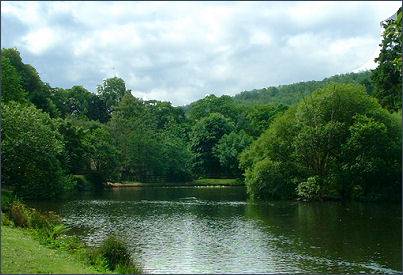Herodsfoot
OS Grid ref:-
 The small village of Herodsfoot in southeast Cornwall is situated around four miles (6 km) to the southwest of the market town of Liskeard and five miles (8 km) north of Looe at a point where two tributaries of the West Looe river join.
The small village of Herodsfoot in southeast Cornwall is situated around four miles (6 km) to the southwest of the market town of Liskeard and five miles (8 km) north of Looe at a point where two tributaries of the West Looe river join.
The name Herodsfoot derives from the Cornish 'Nanshiryarth' which translates as 'the foot of the stream at Heriard'. The name 'Heriard' was changed to Heriod in the seventeenth century and then to Herod in the eighteenth
The area has been settled since medieval times, with boom of the mining industry in Cornwall in the mid 1880s, Herodsfoot was noted for its production of silver, lead and two minerals that are the trade mark of Herodsfoot throughout the world, Bournonite and Tetrahedrite, the village really began to grow. Gunpowder was manufactured at the Herodsfoot Powder Mill, which was used until the mid 1960s when the land and buildings were taken over by the Forestry Commission and used for holiday cabins.
 The West Looe River passes through the village on its way to Looe and there are lots of characterful old cottages. The poet laureate John Betjeman, in his "Shell Guide to Cornwall" described Herodsfoot as "An inland Polperro in a deeply wooded valley. Slate cottages with uneven roofs, the Looe river very small..."
The West Looe River passes through the village on its way to Looe and there are lots of characterful old cottages. The poet laureate John Betjeman, in his "Shell Guide to Cornwall" described Herodsfoot as "An inland Polperro in a deeply wooded valley. Slate cottages with uneven roofs, the Looe river very small..."
During the Civil War, in January 1643 just four miles to the north-west, the Battle of Braddock Down took place, which secured Cornwall for the Royalists under the command of Sir Ralph Hopton.
Herodsfoot is one of 51 Thankful Villages in the UK and the only one in Cornwall , the 'thankful villages' are those that lost no men in World War I. Herodsfoot’s most poignant feature is its stone war memorial, which stands on the small village green. Erected in commemoration of the First World War, its inscription tells us that during the dreadful conflict the community was spared fatalities.
The village Church of All Saints was built high on the hillside in 1850 by the architect John Hayward of Exeter. The Church is a substantial building, buttressed all round under a very high pitched, slate roof and a turret at the Western end hung with a single bell. The font dates to fourteenth century workmanship and came from the ruined chapel of St Martin at Respryn in the village of St Winnow.
The woods around the village provide walks through highly attractive scenery wildlife includes foxes, stoat, and roe deer.